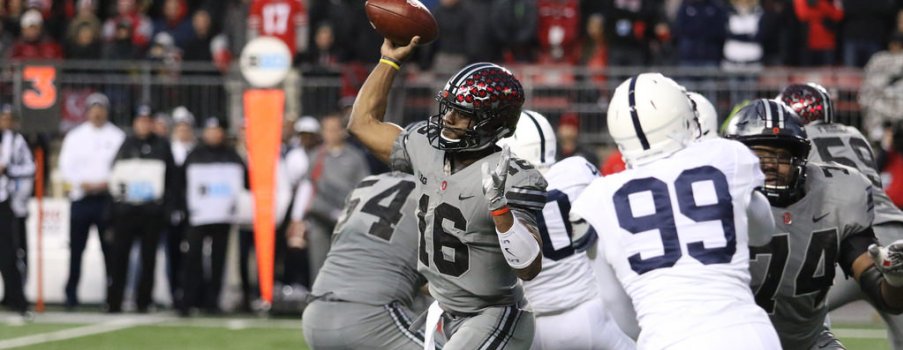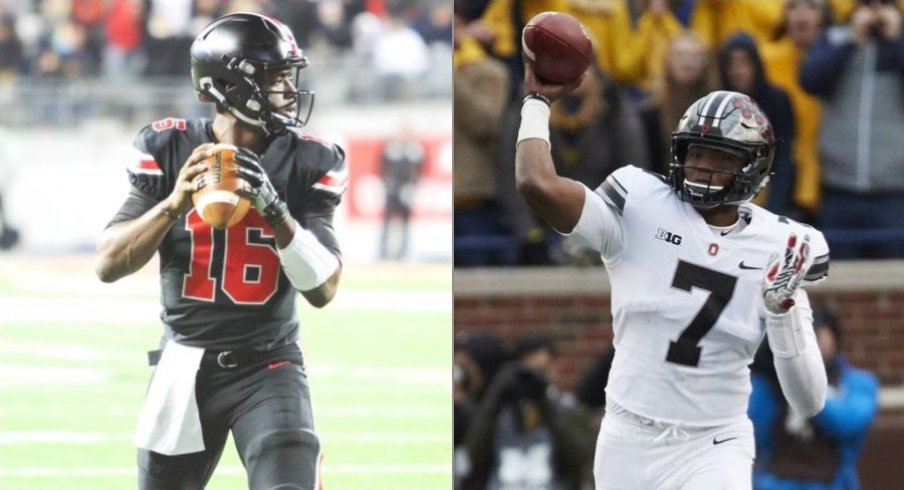A recurring criticism of Ohio State's offense since Urban Meyer's arrival has been its inability to consistently and effectively throw the ball down the field against the best competition on the schedule.
J.T. Barrett bore the brunt of fan outcry over the years but there's no question factors such as playcalling, spotty pass blocking and inconsistent wide receiver play all took turns playing a part in the pass offense's intermittent struggles against tougher defenses.
Over the last two seasons in particular the Barrett-led offense went 8-3 against teams ranked in the AP Top 25 and while that's a respectable winning percentage, Ohio State's aerial attack often limped to the winner's circle. More on that in a bit but first, here's how the passing game fared against ranked teams since Meyer touched down in Columbus:
| YEAR | G | COMP/ATT | COMP% | TOT YDS | YDS/ATT | TD/INT | QB RATING | YDS/G | NATL RANK |
|---|---|---|---|---|---|---|---|---|---|
| 2017 | 5 | 90 / 140 | 64.3% | 1,028 | 7.3 | 8 / 5 | 137.5 | 205.0 | 54 |
| 2016 | 6 | 125 / 201 | 62.2% | 1,226 | 6.1 | 10 / 4 | 125.9 | 204.3 | 52 |
| 2015 | 3 | 37 / 62 | 59.7% | 370 | 6.0 | 3 / 1 | 122.6 | 123.3 | 100 |
| 2014 | 4 | 63 / 103 | 61.2% | 1,055 | 10.2 | 9 / 2 | 172.2 | 263.8 | 32 |
| 2013 | 3 | 41 / 72 | 56.9% | 533 | 7.4 | 7 / 2 | 145.7 | 177.7 | 74 |
| 2012 | 2 | 21 / 32 | 65.6% | 316 | 9.9 | 2 / 0 | 169.2 | 158.0 | 83 |
After the 2014 national championship run saw Cardale Jones rip through three-straight ranked teams, giving that season's passing numbers a huge boost, the 2015 season produced the worst passing stats against ranked teams since 2012.
Though Jones and Barrett both saw action across the 2015 slate it was Barrett who logged all the minutes against the three-straight ranked opponents Ohio State faced to end the season. Logging just 31 combined attempts in a loss to Michigan State and a win over Michigan, Barrett completed 18 throws for 159 yards. The season finale against Notre Dame saw him complete 19 of 31 passes for 211 yards with a touchdown and a pick. In total, fairly pedestrian numbers within a conservative attack relying heavily on Ezekiel Elliott in the run game (well, except for against Michigan State).
With Jones no longer in the fold, Barrett guided the 2016 Buckeyes to a 4-2 record against ranked teams according to cfbstats.com though I think the Penn State was unranked heading into its 24-21 win over the Buckeyes as J.T. threw for 245 yards via a 65% completion rate with a touchdown.
Barrett also lit up No. 14 Oklahoma and No. 10 Nebraska that season but the wheels fell off down the stretch as he completed just 15 of 32 passes against Michigan for 124 yards and a pick in a 30-27 win before bottoming out in a 19 of 33 with two interceptions clunker against Clemson though it should be noted he faced jailbreak after jailbreak thanks to protection breakdowns and a blatant lack of respect for both Barrett's arm and the ability of the outside receivers to gain separation downfield.
When the dust settled on those two performances Barrett averaged 3.9 yards per attempt with three picks and a 52% completion rate. On the season, the Buckeye passing attack ranked 52nd nationally with 204.3 yards per game.
Looking to take advantage of another year of seasoning at both quarterback and in the receiver room heading into the 2017 season, the Buckeyes did manage to go 4-1 against ranked teams but the passing game saw its touchdown-to-interception ratio dive to 8:5 while producing 90 fewer passing yards against ranked teams (205) compared to unranked (295).
The team QB rating against ranked foes stood at 137.5 and while that figure served as an improvement over the last two seasons, when compared to the team QB rating of 170.6 against unranked teams, it marked the biggest disparity among the two figures in a single-season during the Meyer era.
For Barrett's part, he was brilliant against No. 2 ranked Penn State completing 33 of 39 passes for 328 yards and four touchdowns without an interception in a 39-38 come-from-behind thriller but was largely bitten by the inaccuracy and/or interception bug across the four other contests against ranked teams.

In a 31-16 loss to the No. 5 ranked Sooners, Barrett managed just a 54% completion rate with a pick, against No. 13 Michigan State he was better completing 14 of 21 throws for 183 yards with two scores but still tossed a couple interceptions.
Facing Wisconsin in the Big Ten title game he again threw for two touchdowns but also logged two more interceptions and a sub-.500 completion percentage on the strength of a 12-for-26 performance.
Excluding his legendary outing against the Nittany Lions, Barrett threw four touchdowns against five interceptions in the other four games against ranked teams and again it should be noted he didn't always get a lot of help from his receivers and bouts of predictable playcalling.
No matter your feelings about the program's most prolific signal-caller of all time, the keys to the offense have now been handed to a green but rocket-armed Dwayne Haskins who will be flanked by a deadly running back combo and a host of experienced though far from dominant pass catchers.
Conventional wisdom says the quarterback run won't be eliminated from the offense – far from it – but a more aggressive downfield passing attack will at least be attempted on a level not seen since Jones was back deep in the pocket.
For his part, Haskins needs to show decision-making maturity beyond his experience when looking to strike down the field and his receivers need to live up to what has, so far, looked like largely undeserved hype.
Even if Meyer and company don't lean as heavily on the intermediate-to-deep passing attack as often as some fans hope, even moderate success from Haskins in stretching the field should keep defenses from stacking the box at will which no doubt has tailbacks J.K. Dobbins and Mike Weber salivating.
Certainly nothing is guaranteed when it comes to a first-year starting quarterback but the talent and success in a limited sample size seen from Haskins suggests Ohio State's passing offense has a chance to improve when it matters most which is against the toughest opponents on the schedule.



